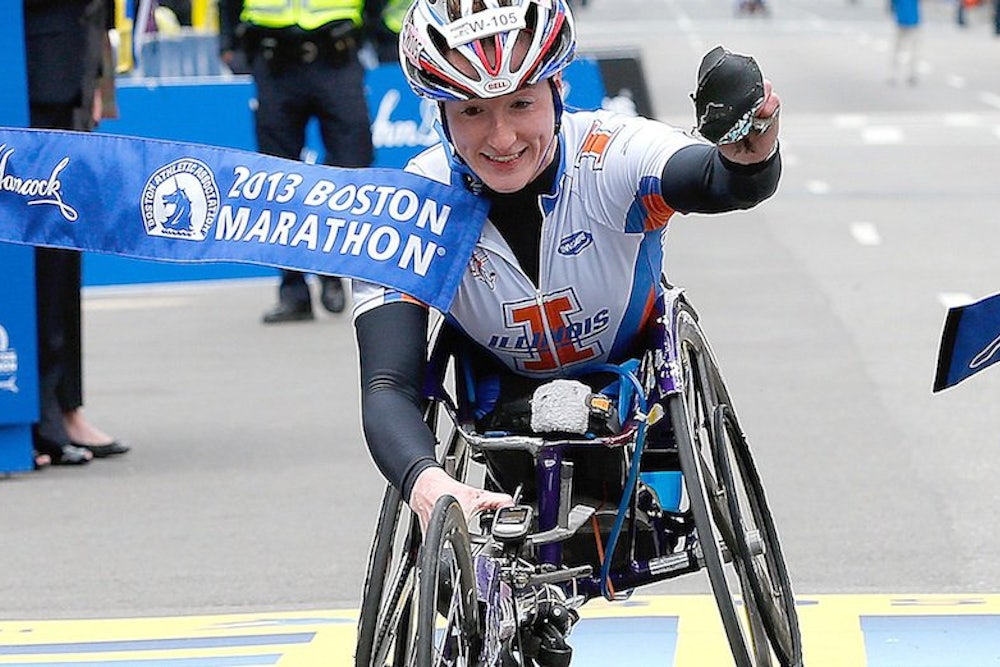The Boston Marathon ended for Jeff Glasbrenner three tenths of a mile from the finish line. Police called out for the runners to stop, but didn't say why. Then people on the sidelines told him: A bomb went off. People lost legs. There are body parts laying on the ground.
Like all the runners, Glasbrenner, a first-time Boston runner from Arkansas, was angry and sickened when he heard what had happened. Like only a few of them, however, he had some idea of what lay ahead for the wounded.
"It hit home," he said Tuesday, "because I am an amputee."
On Monday, as Boston reeled from the attack, one of the earliest details to make it out of Copley Square was the report of severed limbs. "These runners just finished and they don’t have legs now,” one witness told The New York Times. “So many of them. There are so many people without legs." Later, Bostonians recoiled in horror and pity at the gruesome photo of Jeff Bauman Jr., grey-faced and clutching at a leg that ended in tatters of muscle and bone.
But for the many athletes with disabilities, like Glasbrenner, who have long been part of the Marathon community, that image brought a more subtle and complex mix of emotions: sorrow, compassion, and solidarity.
"I wish I could reach out to the people who lost a leg," said Glasbrenner, who lost his leg in a run-in with a hay-cutting machine on his family's farm when he was eight years old. "I'd love to run a race with them."
Over the last forty years, the Boston Marathon has become one of the world's most inclusive sporting events. It was the first marathon to recognize wheelchair racers, in 1975, after a young man named Bob Hall, from Belmont, Massachusetts, wrote to then-race director Will Cloney. Hall wrote that he and some other disabled friends intended to enter the race in their wheelchairs. Cloney wrote back, saying that he would recognize them as finishers if they could make it to the finish line in under three-and-a-half hours.
Hall made it in two hours and fifty-eight minutes.
In the years to come, the Marathon opened its ranks to more and more disabled runners. In the 1980s the Boston Athletics Association added a division for blind runners. Athletes with cerebral palsy have completed the course. So have athletes with lung disease, who ran with oxygen tanks. This year, for the first time, two dwarf runners—Juli Winsor, from Boston, and John Young, from Salem—joined the race.
And of course, every year, there are amputees among the runners, too.
Paul Martin, 45, a Paralympic athlete from Colorado, ran the Marathon last year in the blazing heat. "It was one of the worst experiences I ever put myself through," he recalled yesterday. "I blistered at Mile 11 and ran the rest with blisters on my stump. It sucked, but when you do something that's really frickin' hard, it feels great."
To run on an amputated limb, athletes put on a tight "sock" or sheath over their residual limbs. At the end of the sock, a pin locks into the specialized running prosthesis, the curving carbon-fiber "blade" made famous by South African sprinter Oscar Pistorius.
"It's not exactly comfortable," said Glasbrenner. On Monday, he said, he had to make a pit stop at Mile 25 to adjust his leg. It might have saved his life. "If I hadn't made that stop, I would have been at the finish line when the bomb went off," he said. "I know what these individuals are going to have to go through. They're going to have a long process. They're going to have to hit rock bottom and climb out of it."
Amputation is a "transformative event," said Dr. David Crandell, a former Marathon runner and specialist in amputee rehabilitation at Boston's Spaulding Hospital. His department was preparing to care for any of the survivors who might arrive from other hospitals in the coming days.
"If someone was a runner, they can still be a runner," Crandell said. "Running is cognitive, it's a mindset. How you accomplish the 26.2 is individualistic, but it's a mindset and a desire."
